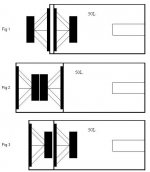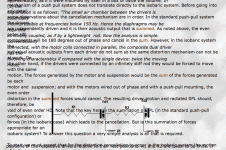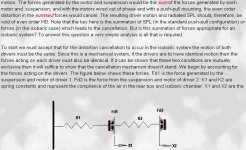Just to continue the other "Push-Pull" thread.

I've read up on the "compound & Iso Barik" theory's. And I understand the deal. What I'm uncertain of is the calculation of the total compound box. Do you calculate the combined volume of the two boxes? Or just the one behind the second woofer?
See my drawing below:
Thanks!

I've read up on the "compound & Iso Barik" theory's. And I understand the deal. What I'm uncertain of is the calculation of the total compound box. Do you calculate the combined volume of the two boxes? Or just the one behind the second woofer?
See my drawing below:
An externally hosted image should be here but it was not working when we last tested it.
Thanks!

Circlomanen said:The chamber between the drivers should be as small as possible.
Yep, and the face-to-face 'clamshell' method is usually ideal, rather than back to back.
BHTX said:
Yep, and the face-to-face 'clamshell' method is usually ideal, rather than back to back.
??? I don't understand. Why wouldn't you fit them in-line, and facing the same way?
That way the volume could be minimised, with the "tail" of the first in the second's "face"? ... taking care that the excursion never exceeded the gap.
Perhaps the cabinetry is trickier, but you would also have the front side of a driver exposed externally. Surely that's better than a rear? (The sound waves not striking the frame.)
Doug
At those frequencies, there is not "striking" of the soundwaves, they just kind of come out. so definitely cone to cone it a good way. Plus, its seldom you see a subwoofer with the motor on the outside. I really would have liked to have done that with my dayton RS 12" woofers. They have nice motors!
tade said:<snip> Plus, its seldom you see a subwoofer with the motor on the outside. <snip>
That's because of the dreaded WAF, mostly! javascript:smilie('
Doug
Well first of all, even though the performance of both of the drivers motors will likely stick closer together, (since they're in the same exact cooling environments), you must also realize that you now have two large sources of heat dissipation stuck right up against each other, and in the same ridiculously small enclosure. Of course, this has the potential to reduce the thermal handling of the two woofers. And on top of that, remember that heat is not only detrimental to the motor, but also to the entire woofer, including the cone! Heat expands. Why would we want warm air trapped between the backs of both drivers? Besides the whole thing regarding both magnets being together in such a small box, I just don't think it's a good idea.
Second, and perhaps even more importantly, you generally want the space for coupling between the two drivers to be as small as possible, since this air between the two woofers adds to the moving mass of the system, and thus results in less than optimal coupling between them. Since your goal is for the two subwoofers to act as one driver, adding a springy mass of air in between the two of them compromises that goal. It'll also have the tendancy to make predictions of the response and modeling of the system more difficult and inaccurate. Using the back-to-back method of isobaric loading shown in the above diagrams, this volume of air between the two drivers will be a bit larger, versus the face-to-face clamshell method. With that said, this method shown above is even worse in that respect, as far as the amount of air between the two drivers, than the piggy-back tunnel loading method, although this method of loading (piggy-back) also won't provide the benefits of cancelling out driver non-linearities.
As a side note, an easy way to think of it is.. as long as both drivers are face-to-face or back-to-back, you'll receive the major benefits of greatly reduced enclosure size from isobaric loading.
Third...with the volume of the coupling chamber being increased even more than the other inferior methods, the total volume of the isobaric enclosure is obviously approching that of a single conventional subwoofer with one of the same drivers. With that said, you're now getting close to losing a major advantage of isobaric loading.
Both the same way? I assume you're referring to the instance of a 'regular' push-pull configuration (not isobaric), where both drivers are mounted conventionally, but with one driver facing the opposite direction, wired out of phase. However, both face-to-face and back-to-back loading arragements causes cancellation of driver non-linearities, cancellation of odd order harmonics, and requires half the enclosure volume than a single driver. Any other push-pull method may give you the first two benefits, but the reduction of required box volume won't exist, as the two woofers aren't physically coupled together.
The main disadvantage to isobaric loading is a fairly significant reduction of 3dB in efficiency per pair of woofers, versus a single one of those woofers. For example, say you have 4 subwoofers, each rated at 87dB/watt. You take those 4 woofers, and put them in two isobaric pairs. Theoretically, efficiency for the combined 4 woofers will still be 87dB with 1 watt applied to each woofer. However, since power handling has also quadrupled, due to using 4 woofers rather than 1, the situation regarding the loss of efficiency can also be seen as being 'evened out' by this large increase of overall power handling of the system.
So, basically, when deciding to go with an isobaric configuration, you're accepting to pay for double the cost of woofers, amplifier power, and possibly having to deal with the disadvantages of having to have at least double the power supply on hand for the massive increase in required amplifier power... all for the main advantage of reducing Vas, and hopefully receiving the other side benefits previously mentioned above.
For most, it's probably not worth it in a home environment. I'd usually prefer a conventional push-pull design, versus isobaric push-pull...unless my enclosure is just insanely huge, or if I want the smallest enclosure possible, or want to attempt impressing less knowledgable and informed individuals with the best low freq extension to enclosure size ratio.
Honestly, I'm still not too clear on the whole reduction of distortion thing with push-pull configurations. I hear and read different claims from different companies and manufacturers, and different opinions and statements from different people. With all that, I just can't get a good grasp on it. I'm currently interested in trying it out myself though.
By the way, I didn't type all of the above solely because I felt someone here needed the information, but so that someone in the future who's attempting to obtain information on the subject might come across it. I didn't search the forum though for info on it yet. I'm guessing there's probably not THAT much out there though. Facts seem to be too cluttered with personal opinions, as well as false statements.
If I myself am misunderstanding anything regarding this subject and have provided false information as a result, please let me know, as I'd very much like to be corrected.
~ Brandin
Second, and perhaps even more importantly, you generally want the space for coupling between the two drivers to be as small as possible, since this air between the two woofers adds to the moving mass of the system, and thus results in less than optimal coupling between them. Since your goal is for the two subwoofers to act as one driver, adding a springy mass of air in between the two of them compromises that goal. It'll also have the tendancy to make predictions of the response and modeling of the system more difficult and inaccurate. Using the back-to-back method of isobaric loading shown in the above diagrams, this volume of air between the two drivers will be a bit larger, versus the face-to-face clamshell method. With that said, this method shown above is even worse in that respect, as far as the amount of air between the two drivers, than the piggy-back tunnel loading method, although this method of loading (piggy-back) also won't provide the benefits of cancelling out driver non-linearities.
As a side note, an easy way to think of it is.. as long as both drivers are face-to-face or back-to-back, you'll receive the major benefits of greatly reduced enclosure size from isobaric loading.
Third...with the volume of the coupling chamber being increased even more than the other inferior methods, the total volume of the isobaric enclosure is obviously approching that of a single conventional subwoofer with one of the same drivers. With that said, you're now getting close to losing a major advantage of isobaric loading.
richie00boy said:Putting them both the same way loses the benefits of push-pull.
Both the same way? I assume you're referring to the instance of a 'regular' push-pull configuration (not isobaric), where both drivers are mounted conventionally, but with one driver facing the opposite direction, wired out of phase. However, both face-to-face and back-to-back loading arragements causes cancellation of driver non-linearities, cancellation of odd order harmonics, and requires half the enclosure volume than a single driver. Any other push-pull method may give you the first two benefits, but the reduction of required box volume won't exist, as the two woofers aren't physically coupled together.
The main disadvantage to isobaric loading is a fairly significant reduction of 3dB in efficiency per pair of woofers, versus a single one of those woofers. For example, say you have 4 subwoofers, each rated at 87dB/watt. You take those 4 woofers, and put them in two isobaric pairs. Theoretically, efficiency for the combined 4 woofers will still be 87dB with 1 watt applied to each woofer. However, since power handling has also quadrupled, due to using 4 woofers rather than 1, the situation regarding the loss of efficiency can also be seen as being 'evened out' by this large increase of overall power handling of the system.
So, basically, when deciding to go with an isobaric configuration, you're accepting to pay for double the cost of woofers, amplifier power, and possibly having to deal with the disadvantages of having to have at least double the power supply on hand for the massive increase in required amplifier power... all for the main advantage of reducing Vas, and hopefully receiving the other side benefits previously mentioned above.
For most, it's probably not worth it in a home environment. I'd usually prefer a conventional push-pull design, versus isobaric push-pull...unless my enclosure is just insanely huge, or if I want the smallest enclosure possible, or want to attempt impressing less knowledgable and informed individuals with the best low freq extension to enclosure size ratio.
Honestly, I'm still not too clear on the whole reduction of distortion thing with push-pull configurations. I hear and read different claims from different companies and manufacturers, and different opinions and statements from different people. With all that, I just can't get a good grasp on it. I'm currently interested in trying it out myself though.
By the way, I didn't type all of the above solely because I felt someone here needed the information, but so that someone in the future who's attempting to obtain information on the subject might come across it. I didn't search the forum though for info on it yet. I'm guessing there's probably not THAT much out there though. Facts seem to be too cluttered with personal opinions, as well as false statements.
If I myself am misunderstanding anything regarding this subject and have provided false information as a result, please let me know, as I'd very much like to be corrected.
~ Brandin
Thanks Brandin,
I guess it all depends on the driver and what you want to achieve with it. And the physical size of it.
Like for an example getting the maximum bass out of a small woofer like 5" or 6" in the smallest possible enclosure. Normally takes a large vented box, but with iso-barik with a "small" woofer makes for half the size.
Since I'm in the recording business we like to play loud. So more bass woofers the better......in a small size.....
What about putting a tube between the woofers to reduce air?Same size as the baffel cut out?
/L
I guess it all depends on the driver and what you want to achieve with it. And the physical size of it.
Like for an example getting the maximum bass out of a small woofer like 5" or 6" in the smallest possible enclosure. Normally takes a large vented box, but with iso-barik with a "small" woofer makes for half the size.
Since I'm in the recording business we like to play loud. So more bass woofers the better......in a small size.....

What about putting a tube between the woofers to reduce air?Same size as the baffel cut out?
/L
"Putting them both the same way loses the benefits of push-pull.
No I was referring to Brisso57's comment about putting them in 'train carriage' formation."
If you by this means to have the cones "facing" the same direction, I believe you are wrong if I understand the "Cookbook" correctly, the config with two woofers connected by a tube, chapter 2 I believe.
No I was referring to Brisso57's comment about putting them in 'train carriage' formation."
If you by this means to have the cones "facing" the same direction, I believe you are wrong if I understand the "Cookbook" correctly, the config with two woofers connected by a tube, chapter 2 I believe.
http://www.musicanddesign.com/Isobaric.html
Is it correct to understand it so, that doing an isobarik push/pull design will yield few, if any advantages over a push/pull design according to the simulations regarding distortion?
john k... said:
Nicely explained. Thanks, John!
buggsson said:
Is it correct to understand it so, that doing an isobarik push/pull design will yield few, if any advantages over a push/pull design according to the simulations regarding distortion?
It would be correct to say that the isobaric PP system offer no advantages over a standard PP design with regard to distortion. Even if the isobaric volume shrinks to zero the reduced rear box volume would result in greater air nonlinearity and higher distortion in general.
So, if one choose to go ahead with the Fig. 2 option in the first post, how tight can you put the two woofers? Can you put them back to back so that the magnets connect, with maybe some felt i between, or has there to be some minimal distance?
Is the heat buildup really an issue with normal music listening for such a setup, that is, using a tube?
Is the heat buildup really an issue with normal music listening for such a setup, that is, using a tube?
buggsson said:So, if one choose to go ahead with the Fig. 2 option in the first post, how tight can you put the two woofers? Can you put them back to back so that the magnets connect, with maybe some felt i between, or has there to be some minimal distance?
Is the heat buildup really an issue with normal music listening for such a setup, that is, using a tube?
Buggson,
I've attached the 3 ways of creating an isobarik chamber for essentially the same result. I say essentially, as there are factor other than the alignment that would affect how it works. And some of them I don't know how to quantify.
In fig 1. the motors of each driver is exposed to a large volume of air and should be able to cool sufficiently. This should also be true for a sealed device, as the 'inside' woofer will be 'exposed' to 50l of air to remove heat from the voice coil. This configuration, according to John K's link (earlier) should not result in much reduction of harmonic distortion. But, for removal and attachment of the woofers, it should be a simple trick to keep the woofers attached to a single panel and attach this to (or remove it from) the box inorder to work on the inside.
If fig 2. the motors of both drivers are trapped in a very small enclosure, and the effects of heat build-up may affect either or both of the woofers even when not much power is being fed into them (compression effects). Harmonic distortion should also not be improved much. Removal and attachment of the inside woofer could be quite a problem unless a removable panel is designed into the system. And, the effects caused by having the 2 magnets so close together may be great or may be very little - I am not qualified to comment.
If fig 3. one motor is trapped in a small volume (the iso chamber) and the other is in the larger enclosure. This means that there will be less effect on the voice coils from heat - although if it gets used at high volumes and for long periods then the 'front' woofer may be affected. Harmonic distortion as above. The removla of the inside woofer again is a problem in this set-up, again requiring a removable panel.
For those wondering why you might want to remove of attach the woofers after you've attached them for the first time - try putting in or removing stuffing after you've glued it all together...
Attachments
john k... said:
John, some parts of this page are a bit hard to read....
dave
Attachments
planet10 said:John, some parts of this page are a bit hard to read....
dave
dave,
Works for me on IE 6.0 (at work). I don't think I've read this at home on Firefox (yet).
Attachments
- Status
- This old topic is closed. If you want to reopen this topic, contact a moderator using the "Report Post" button.
- Home
- Loudspeakers
- Subwoofers
- Compound , Iso-Barik


